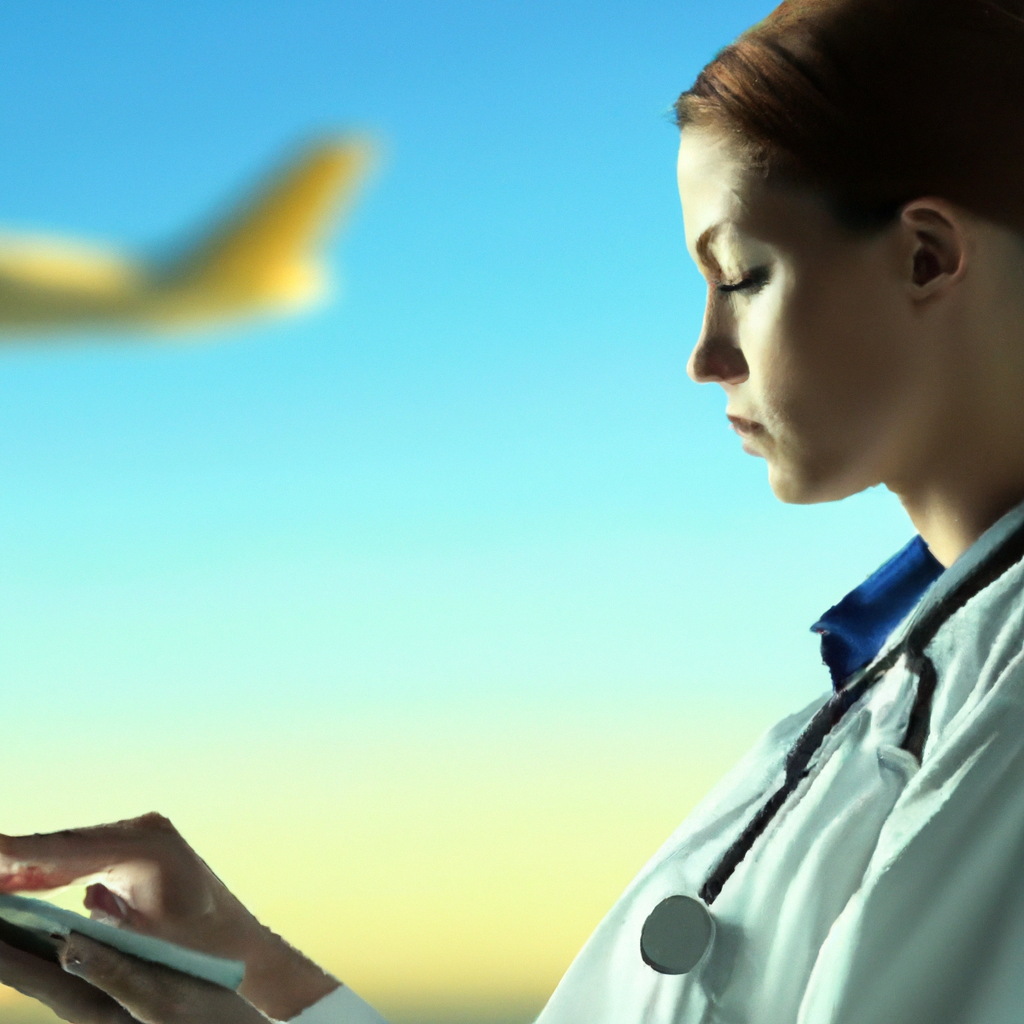In today’s fast-paced world, air travel has become a common mode of transportation. However, the possibility of medical emergencies during flights is always a concern. That’s where telemedicine integration comes in. This innovative technology allows medical professionals on the ground to remotely assess and assist in-flight medical situations, providing real-time expert advice to cabin crew and even passengers themselves. With telemedicine integration, airlines can enhance their in-flight medical care capabilities, ensuring the safety and well-being of everyone on board. In this article, we will explore how telemedicine integration works and the benefits it brings to in-flight medical emergencies.

Introduction to Telemedicine Integration in Air Ambulances
Telemedicine integration refers to the incorporation of telecommunication technologies and medical expertise into air ambulance services. It allows for real-time communication, remote monitoring, and medical decision-making in-flight, enhancing the overall quality of care provided to patients during air transport. This article will explore the definition, importance, advantages, and challenges of integrating telemedicine in air ambulances.
Definition of Telemedicine Integration
Telemedicine integration in air ambulances involves the use of telecommunication technologies to facilitate communication and provide medical support to the onboard medical staff. It encompasses various aspects, such as real-time communication between medical staff, consultations with ground-based medical professionals, access to medical history and diagnostic tools, and remote medical decision-making.

Importance of Telemedicine in Air Ambulances
Telemedicine plays a crucial role in air ambulances as it enables instant communication and collaboration between the medical team onboard and the ground-based professionals. This real-time connection allows for timely consultations, accurate diagnosis, and appropriate treatment decisions, ultimately improving patient outcomes. In emergency situations, where time is of the essence, the integration of telemedicine can be life-saving.
Advantages of Integrating Telemedicine In-Flight
There are several advantages to integrating telemedicine in-flight. Firstly, it allows for immediate consultation and coordination with ground-based medical professionals. By discussing the patient’s condition and receiving expert opinions, the onboard medical team can make well-informed decisions. Secondly, telemedicine enables remote monitoring of vital signs, ensuring continuous assessment of the patient’s health status during the journey. Additionally, access to medical history and diagnostic tools supports efficient decision-making and streamlined care.

Challenges of Implementing Telemedicine in Air Ambulances
While the integration of telemedicine in air ambulances brings significant benefits, it also poses some challenges. One such challenge is the need for reliable and robust telecommunication infrastructure, particularly in remote or inaccessible areas. Poor connection quality can hinder real-time communication and data transmission. Another challenge is ensuring the compatibility and interoperability of telemedicine systems with various technological devices used in air ambulances. Additionally, regulations and legal considerations surrounding telemedicine practices must be taken into account to ensure compliance and patient privacy.
Using Telemedicine to Improve Communication
Real-time communication between medical staff on board
Integrating telemedicine allows for seamless communication between the medical team on board the air ambulance. Through videoconferencing or secure messaging platforms, doctors, nurses, and paramedics can discuss the patient’s condition, share observations, and make important decisions collectively. This real-time exchange of information facilitates coordinated care and enhances the overall quality of medical services provided during transport.
Consultations with ground-based medical professionals
Telemedicine integration enables air ambulance crews to connect with ground-based medical professionals, such as emergency physicians or specialists, for expert consultations. These consultations provide valuable insights, allowing for better assessment of the patient’s condition and informed decision-making. Additionally, ground-based physicians can guide the onboard medical team through complex procedures or provide specific treatment recommendations, ensuring optimal care delivery.
Coordinating care with receiving hospitals
Telemedicine integration allows for effective communication and coordination between the air ambulance crew and the receiving hospital. Before landing, the onboard medical team can communicate vital patient information, relay diagnostic findings, and inform the hospital staff about the required resources or specialized equipment. This seamless handover ensures a smooth transition of care, reducing the risk of miscommunication and improving patient outcomes.
Facilitating communication between aircrew and medical team
Integration of telemedicine fosters better communication between the aircrew and the medical team, ensuring a safe and efficient working environment. The aircrew can relay important flight-related information, such as turbulence, air traffic delays, or alternative landing options, to the medical team. Similarly, the medical team can provide updates on the patient’s condition or any immediate medical needs to ensure optimal coordination and safety throughout the journey.

Enhancing Diagnostics and Monitoring
Remote monitoring of vital signs
One of the key advantages of telemedicine integration is the ability to remotely monitor the patient’s vital signs during air transport. Wireless sensors and monitoring devices can be used to continuously track essential parameters like heart rate, blood pressure, oxygen saturation, and respiratory rate. Real-time monitoring allows the medical team to detect any changes in the patient’s condition promptly and take appropriate actions.
Access to medical history and records
Integrating telemedicine in air ambulances provides instant access to the patient’s medical history, including previous diagnoses, medications, allergies, and test results. This information is crucial for the onboard medical team to make accurate diagnoses and informed treatment decisions. Furthermore, it helps prevent adverse drug interactions or provide appropriate interventions based on the patient’s medical background.
Using telemedicine for diagnostic imaging
Telemedicine technology enables remote access to diagnostic imaging tools, such as X-rays, ultrasounds, or CT scans, during air transport. The medical team can share imaging results with specialists on the ground for a more accurate interpretation. This collaboration allows for an informed diagnosis and timely implementation of appropriate treatment plans, even when thousands of feet above the ground.
Utilizing portable medical devices
Integrating telemedicine in air ambulances involves the use of portable medical devices that can be easily transported and used in-flight. These devices include portable ultrasound machines, handheld electrocardiograms (ECGs), and compact laboratory analyzers. The availability of such devices empowers the onboard medical team to perform quick assessments, obtain diagnostic information, and initiate treatment promptly.
Telemedicine for Medical Decision-Making
Remote medical consultations
Telemedicine integration enables air ambulance crews to connect with medical professionals in real-time, even when flying at high altitudes or over remote areas. This allows for remote medical consultations, where experts can provide guidance, advice, or recommendations for complex cases. With access to expert opinions, the onboard medical team can make well-informed decisions regarding diagnosis, treatment, and appropriate medical interventions.
Expert opinions and second opinions
When facing complex medical situations or rare conditions, telemedicine integration allows air ambulance crews to seek out expert opinions or second opinions from specialists in various fields. This collaborative approach enhances the accuracy of diagnosis and the effectiveness of treatment plans. By leveraging the expertise of specialists, the onboard medical team can provide the best possible care to patients in-flight.
Real-time access to medical reference materials
Integrating telemedicine in air ambulances provides real-time access to medical reference materials, such as medical textbooks, treatment guidelines, or drug formularies. These resources can be accessed digitally, ensuring that the onboard medical team has the most up-to-date information readily available. This immediate access enhances medical decision-making and promotes evidence-based practice.
Diagnosing and treating medical emergencies
Telemedicine integration empowers air ambulance crews to diagnose and treat medical emergencies in-flight effectively. By leveraging telecommunication technologies and remote access to medical resources, the onboard medical team can collaborate with experts, obtain critical information, and initiate life-saving interventions promptly. This efficient medical decision-making process can significantly improve patient outcomes in critical situations where every minute counts.

Training and Education in Air Ambulance Settings
Providing medical training to aircrew
Integrating telemedicine in air ambulances allows for the provision of medical training to the aircrew. This training ensures that non-medical personnel, such as pilots or flight attendants, have the necessary knowledge and skills to respond to emergencies effectively. Topics covered in training sessions may include basic life support, first aid, cabin safety, and emergency procedures. By equipping the aircrew with medical training, the overall preparedness and safety of air ambulance operations can be enhanced.
Continuing education for medical professionals
Telemedicine integration also facilitates continuing education for medical professionals working in air ambulances. Through teleconferences, webinars, or online courses, medical staff can stay up-to-date with the latest advancements, guidelines, and best practices in emergency medicine. Continuous learning enhances their clinical skills, critical thinking, and decision-making abilities, leading to improved patient care during air transport.
Simulated medical scenarios and case studies
Virtual simulation platforms can be utilized in air ambulance settings to conduct simulated medical scenarios and case studies. These simulations allow medical professionals to practice critical procedures, improve teamwork, and enhance their problem-solving skills in a safe and controlled environment. By engaging in realistic scenarios, the onboard medical team can refine their skills, identify areas for improvement, and increase confidence in managing in-flight emergencies.
Sharing knowledge and expertise globally
Telemedicine integration opens up avenues for global collaboration and knowledge sharing among air ambulance services worldwide. Through teleconferences, forums, or online platforms, medical professionals from different regions can exchange experiences, discuss challenging cases, and share best practices. This sharing of knowledge and expertise fosters continuous improvement in air ambulance care and promotes a standardized approach to in-flight medical services.
Telemedicine Integration: Regulatory and Legal Considerations
Compliance with telemedicine regulations
Integrating telemedicine in air ambulances requires compliance with telemedicine regulations and guidelines set forth by relevant authorities. These regulations ensure the safe and ethical delivery of healthcare services via telecommunication technologies. Air ambulance services must adhere to legal requirements concerning licensure, medical practice, privacy, security, and data protection.
Licensing and credentialing requirements
Medical professionals involved in telemedicine practices within air ambulances need to comply with licensing and credentialing requirements specific to their jurisdiction. These requirements may include holding appropriate medical licenses, certifications, or specialized training in telemedicine. Following these regulations is essential to ensure the competence and legitimacy of the medical professionals providing care in-flight.
Patient privacy and data protection
Integrating telemedicine in air ambulances necessitates strict adherence to patient privacy laws and data protection regulations. Medical information transmitted or stored electronically must be kept confidential and secure. Air ambulance services must implement robust data encryption, access controls, and privacy policies to safeguard patient confidentiality and protect sensitive medical data.
Liability and malpractice issues
The integration of telemedicine in air ambulances introduces legal considerations regarding liability and malpractice. Clear protocols, guidelines, and standard operating procedures must be established to outline the roles, responsibilities, and limitations of the medical professionals involved. Air ambulance services should also have appropriate insurance coverage and risk management strategies in place to mitigate potential liabilities or malpractice claims arising from telemedicine practices.
Technological Advancements and Innovations
Advancements in telecommunication technologies
The field of telecommunication technologies is constantly evolving, bringing forth advancements that can enhance telemedicine integration in air ambulances. High-speed wireless connectivity, improved videoconferencing systems, and secure messaging platforms enable seamless communication and data transmission during air transport. Embracing these technological advancements enhances the efficiency and effectiveness of telemedicine integration.
Remote access to medical devices
Telemedicine integration allows for remote access to various medical devices from aboard an air ambulance. For example, through secure network connections, medical professionals can remotely control or monitor devices such as ultrasound machines, ECG monitors, or laboratory analyzers located in the air ambulance. This remote access ensures that specialized diagnostic tools are readily available, even when physical access to these devices is limited.
Artificial intelligence in telemedicine
Artificial intelligence (AI) is increasingly being used in telemedicine to assist medical professionals during in-flight care. AI algorithms can analyze complex data sets, identify patterns, and provide predictive analytics, aiding in diagnosis, treatment planning, and monitoring. AI can help in interpreting medical images, triaging patients, or alerting medical professionals to critical changes in vital signs, supporting rapid and accurate decision-making during air transport.
Augmented reality for medical procedures
Augmented reality (AR) technology has the potential to revolutionize in-flight medical procedures within air ambulances. Medical professionals can wear AR-enabled devices that superimpose digital information onto the real-world environment. This technology can assist in procedures such as difficult intubations or ultrasound-guided vascular access, providing real-time guidance and enhancing the accuracy and safety of interventions.
Case Studies of Successful Telemedicine Integration
Air ambulance services using telemedicine effectively
Several air ambulance services have successfully integrated telemedicine into their operations, enhancing in-flight medical care. For example, a case study of a helicopter emergency medical service found that telemedicine consultations with neurologists resulted in more accurate stroke diagnoses and appropriate treatment recommendations. Another study demonstrated the effectiveness of telemedicine consultations for managing cardiac arrest cases during air transport, leading to improved outcomes.
Positive outcomes and patient experiences
Real-life implementations of telemedicine integration in air ambulances have shown positive outcomes and improved patient experiences. By leveraging telemedicine, air ambulance services have achieved reduced transport times, increased accuracy in diagnoses, and better utilization of medical resources. Patients have reported feeling safer and more reassured knowing that expert medical opinions are readily available, leading to increased satisfaction with the care received during in-flight medical transport.
Lessons learned from real-life implementations
Real-life implementations of telemedicine integration in air ambulances have provided valuable lessons and insights. These implementations have highlighted the importance of robust telecommunication infrastructure, standardized protocols and procedures, training and education of medical professionals, and continuous monitoring and evaluation of the telemedicine systems. Sharing these lessons learned across air ambulance services can contribute to the improvement and standardization of telemedicine practices globally.
Future potential of telemedicine in air ambulances
The future potential of telemedicine in air ambulances is vast and promising. Advancements in technology, such as 5G networks, miniaturized medical devices, or AI-driven decision support systems, will further enhance the capabilities and scope of telemedicine integration. Remote triage systems for emergency response, integration with unmanned aerial vehicles (UAVs), and standardized telemedicine protocols across air ambulance services hold promise for revolutionizing in-flight medical care.
Considerations for the Future
Expanding telemedicine capabilities in-flight
As technology continues to advance, air ambulance services should strive to expand their telemedicine capabilities in-flight. This includes upgrading telecommunication systems, investing in portable medical devices, and training medical professionals to effectively utilize telemedicine tools. By expanding telemedicine capabilities, air ambulance services can provide enhanced medical care regardless of location or the complexity of the case.
Integration with unmanned aerial vehicles (UAVs)
The integration of telemedicine with unmanned aerial vehicles (UAVs) holds significant potential for air ambulance services. UAVs equipped with telemedicine capabilities can rapidly reach remote or disaster-stricken areas, providing critical medical support and expertise in emergency situations. These unmanned systems can facilitate the delivery of medical supplies, perform remote diagnostics, and even participate in emergency medical procedures under the guidance of onboard medical professionals.
Remote triage and emergency response
Telemedicine integration in air ambulances can extend beyond in-flight care to include remote triage and emergency response. By connecting with individuals in need of medical assistance via telecommunication technologies, medical professionals can assess the severity of the situation, provide immediate guidance and interventions, and determine if air transport is required. This remote triage and emergency response can save valuable time, resources, and potentially lives.
Standardization and interoperability
The standardization and interoperability of telemedicine systems across air ambulance services are vital for efficient and effective care delivery. Standardized protocols and guidelines ensure consistency in practice, irrespective of the air ambulance service provider. Interoperability between different telemedicine systems allows for seamless communication and data exchange between air ambulances, ground-based medical professionals, and receiving hospitals, thereby enhancing continuity of care.
Conclusion
The integration of telemedicine in air ambulances revolutionizes in-flight medical care, offering real-time communication, enhanced diagnostics and monitoring, medical decision-making support, and continuous training opportunities. Despite challenges related to infrastructure, regulations, and liability, telemedicine integration brings significant advantages to air ambulance services. As technology continues to evolve, the future potential of telemedicine in air ambulances is vast, promising further advancements and improvements in in-flight medical care.



